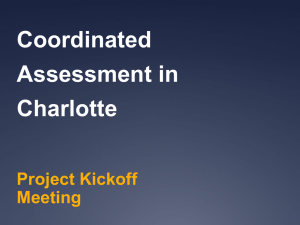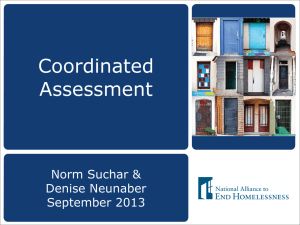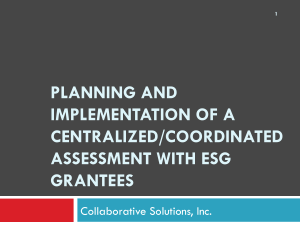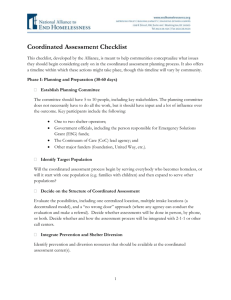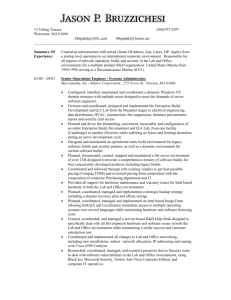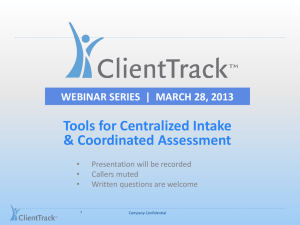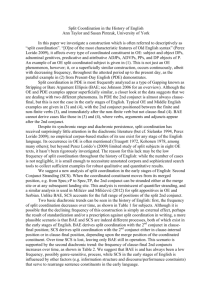Implementing Coordinated Assessment Under the New CoC
advertisement
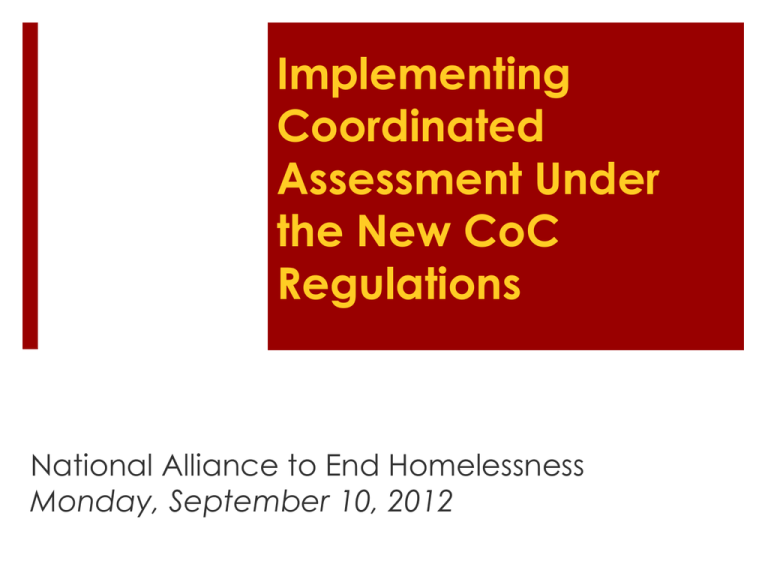
Implementing Coordinated Assessment Under the New CoC Regulations National Alliance to End Homelessness Monday, September 10, 2012 Logistical Notes Participants are muted. Any questions should be entered in the box at the bottom of your webinar panel. Unanswered questions may be addressed in future blog posts or other materials. Webinar is being recorded. Agenda for Today’s Webinar What is coordinated assessment? What do the regulations say about coordinated assessment? What are the key aspects of a coordinated assessment process? What does the Alliance recommend considering or doing as you develop a coordinated assessment process? What are some basic next steps? Latest News from HUD CoC interim rule went into effect on August 30 Comments are being accepted until October 1 New technical assistance products are available on HUD HRE website New Alliance products: summary available now, draft comments and recommendations coming soon Definition of Coordinated Assessment “Centralized or coordinated assessment system is defined to mean a centralized or coordinated process designed to coordinate program participant intake, assessment, and provision of referrals. A centralized or coordinated assessment system covers the geographic area, is easily accessed by individuals and families seeking housing or services, is well advertised, and includes a comprehensive and standardized assessment tool.” (Section 578.3) Potential Models Centralized Decentralized Telephone-based/2-1-1 Mobile case manager Mixed Written Standards Communities must develop written standards for transitional housing, rapid re-housing, and permanent supportive housing that cover: Eligibility Prioritization Method for determining appropriate amount of rent household should pay * High-performing communities – prevention asssitance Other Items of Note Should be designed locally Must work with Emergency Solutions Grant (ESG) grantees Key Aspects Key Aspects Access Assessment Data Entry and Sharing Referral Program Intake* System Change Key Points: Access and Assessment Access: Do consumers know how to reach the assessment centers? Are they easy to reach? Assessment: Do you have a consistent, standardized process for determining consumer need? Key Points: Data and Referral Data: Do you have a reliable data system that is being used properly? Referral: Is there a process in place for guiding consumers needing to enter the system to the right program based on their needs? Key Points: Intake and System Change Intake: What happens when consumers enter the system? System Change: How will programs and resources change to become more efficient, effective, and better accommodate need? Recommendations Based on CoC regulations No. 1: Plan a system that includes accommodations for domestic violence survivors Consider safety, certification, and data concerns Ensure DV survivors are connected to housing opportunities Examples: Montgomery County/Dayton, OH; Whatcom County, WA; Grand Rapids, MI No. 2: Include prevention and shelter diversion Consolidate emergency rental assistance funds at the front door Develop brief prevention/diversion screening tool Have case managers ready to mediate tenant disputes No. 3: Break down program barriers Identify people being screened out Look at entrance requirements with a system lens (incorporating cost, need, model) No. 4: Develop written standards based on best practice Use written standards to support careful targeting and best practice Ensure higher-cost, service-intensive interventions support households with the most difficult barriers to being re-housed Think progressive engagement Next Steps Getting Started Select a steering committee Develop a model and identify populationappropriate assessment centers Sketch out current and desired processes Next Steps: Access and Assessment Access: Establish assessment sites, keeping in mind current consumer patterns. Assessment: Develop a prevention/diversion screening tool and identify who will administer it. Next Steps: Data and Referral Data: Develop a data sharing form and a protocol for sharing bed availability. Referral: Begin working on written standards. Next Steps: Intake and System Change Intake: Cut duplication. System Change: Close “side doors” and begin reviewing program entrance requirements. Other Considerations How assessment will work for different populations Role of outreach team Evaluation and adjustment strategy Additional Resources Coordinated Assessment Toolkit USICH Retooling Crisis Response Systems Toolkit HUD Coordinated Assessment Guidebook – coming soon Questions? Webinar IS being recorded. For questions about the webinar or coordinated assessment: thecenter@naeh.org
